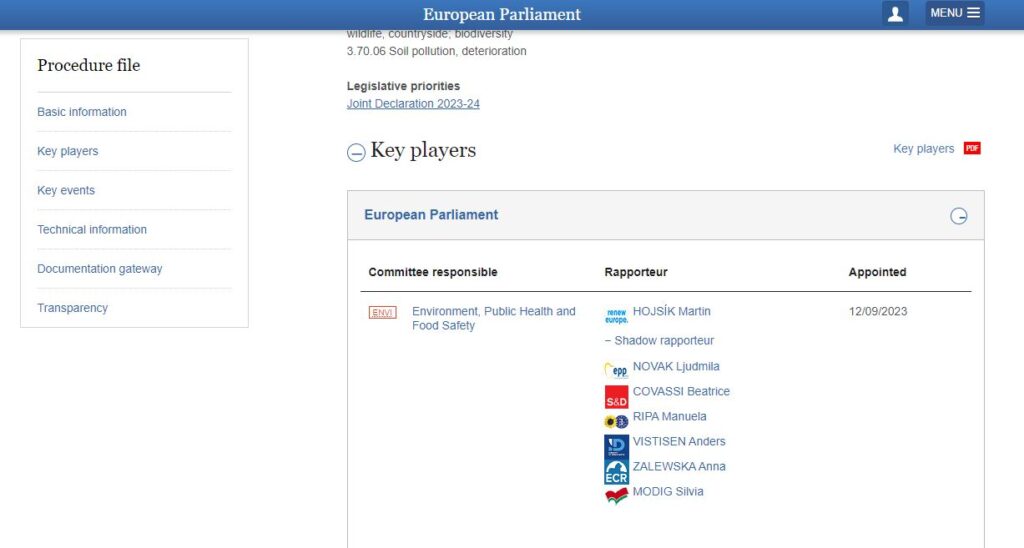
This month’s GeoPolicy Blog post unpacks the Directive on Soil Monitoring and Resilience, it’s impacts from research to regulation and how scientists can get involved with it.
It can be challenging for scientists to understand and engage with the European policymaking process. The intricacies and nuances of the legislative process, with its numerous institutions, committees, and political procedures, can appear daunting to those on the outside and it isn’t always clear who is making the decisions and when they require external input and information. One of the best ways for the scientific community to get a better understanding of this legislative process is to select a new policy and follow it through each stage of the legislative process! In this month’s GeoPolicy Blog, we’ll be diving into the new Directive on Soil Monitoring and Resilience to get a better understanding about what it aims to achieve, how it came to be, and the next steps that it will go through before (hopefully) being adopted!
What does the Directive on Soil Monitoring and Resilience hope to achieve?
Over 60% of European soils are considered to be in an unhealthy state with scientific evidence showing that this percentage is increasing. Degraded soil undermines the delivery of crucial ecosystem services that support nutrient recycling, carbon sequestration, water regulation, and subsequently food and timber production. Not only does this influence farmers and food security, but also Europe’s economy, climate and biodiversity targets, and resilience to disasters such as droughts and floods. Despite this, soil currently does not receive the same level of legal protection in the EU as air and water.
This Directive aims to provide a harmonised definition of soil health, create and implement a comprehensive and coherent monitoring framework, and provide guidelines about how soil should be sustainable managed and remediated where necessary.
How was the Directive proposed?
This Directive was initially inspired by a call from the European Parliament, stakeholders and citizens who called on the European Commission to develop a legal framework for the protection and sustainable use of soil. This resulted in the creation of the EU Soil Strategy for 2030 which was adopted by the Commission on 17 November 2021 and aims to have all EU soil ecosystems in a healthy condition by 2050. The Directive on Soil Monitoring and Resilience was proposed by the European Commission to support this overarching goal. During the construction of the Directive, the Commission’s Directorate-General for Environment received inputs from a wide range of sources including the European Commission’s in-house science service, the Joint Research Centre. They then incorporated input from other Directorate-Generals as well as external stakeholders through various EU Consultations. Once published, the proposed legislation was passed onto the European Parliament and Council of the European Union (known as the Council) to be amended and either passed or rejected.
How will the Directive amended?
Now that the Directive has been proposed by the Commission, both the European Parliament and Council will amend it. From the Parliament side, the initial discussions for this Directive will take place within the Committee on the Environment, Public Health and Food Safety. Member of the European Parliament (MEP) Martin Hojsik was selected by this Committee to be the file’s rapporteur along with six other shadow rapporteurs – one from each of the European Parliament’s Political Groups. These rapporteurs are responsible for drafting a report with the help of experts that is then used by the Committee during the legislative process. This means that they are also likely to be the MEPs who are most interested in receiving information and recommendations from external experts! If you’re interested in providing science advice or relevant information on a particular legislative file, it’s important to make sure you have read the file and that your comments refer to specific areas within the legislation. This will enable the MEPs to propose and then discuss specific amendments to the text. While the amendment process can take many months, the earlier that you are able to provide input in the process, the easier it will be for the relevant MEPs to consider it.
In some cases, thousands of amendments are suggested for a single legislative file. If this is the case, Compromise Amendments will often be created and then voted on. However, if a Compromise Amendment is rejected, the Committee will return to the original amendments suggested and vote on each individually. Once the Committee responsible has voted on the legislation, it then moves to the Plenary where it is voted on by all 705 Members of the European Parliament.
What about the Council?
It’s not only the European Parliament that discusses and amends European legislation, but also the Council of the European Union (known a the Council). The Council consists of national government ministers from each member state, grouped by policy area. Compared with the European Parliament, it is generally more challenging for researchers and scientists get in touch and with relevant individuals working within Council configurations.
What are the next steps?
If both the Parliament and Council adopt amended versions of the Directive on Soil Monitoring and Resilience during the ordinary legislative procedure, they will have to work together to create a finalised text. This is known as the Trilogue phase and will be overseen by the Commission (who drafted the original version of the Directive). As already mentioned, while input from external stakeholders and the scientific community can be useful during this time if it addresses the specific areas that will be negotiated, the earlier input is provided the easier it is for policymakers to incorporate it. The Trilogue is also much less public and therefore it is often difficult for those on the outside to know what information or scientific evidence would be useful.
More information:
You can follow the steps and stages of the Directive on Soil Monitoring and Resilience via the European Parliament’s Legislative Train. You can also read more general information about the Directive here.

